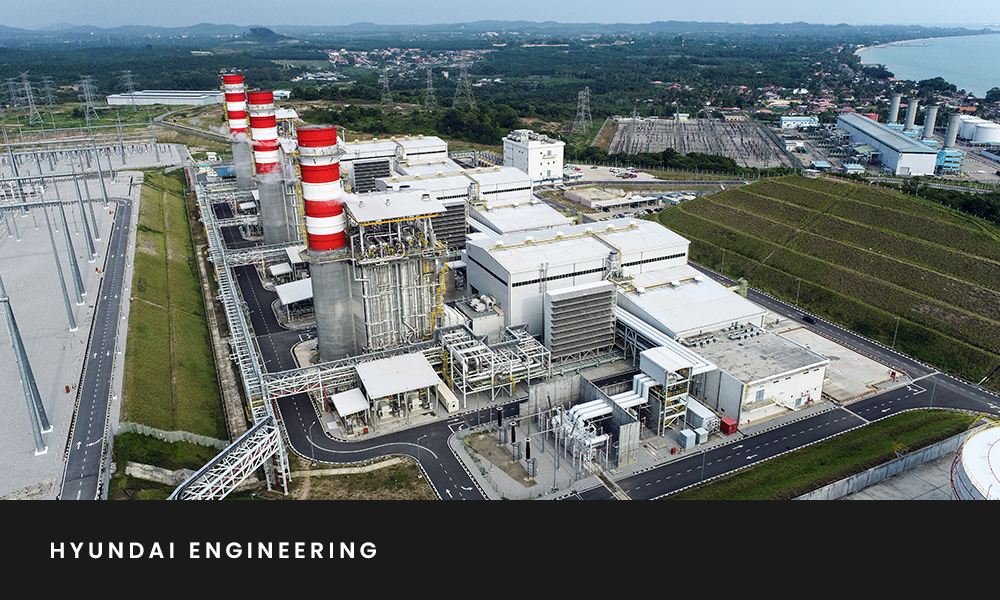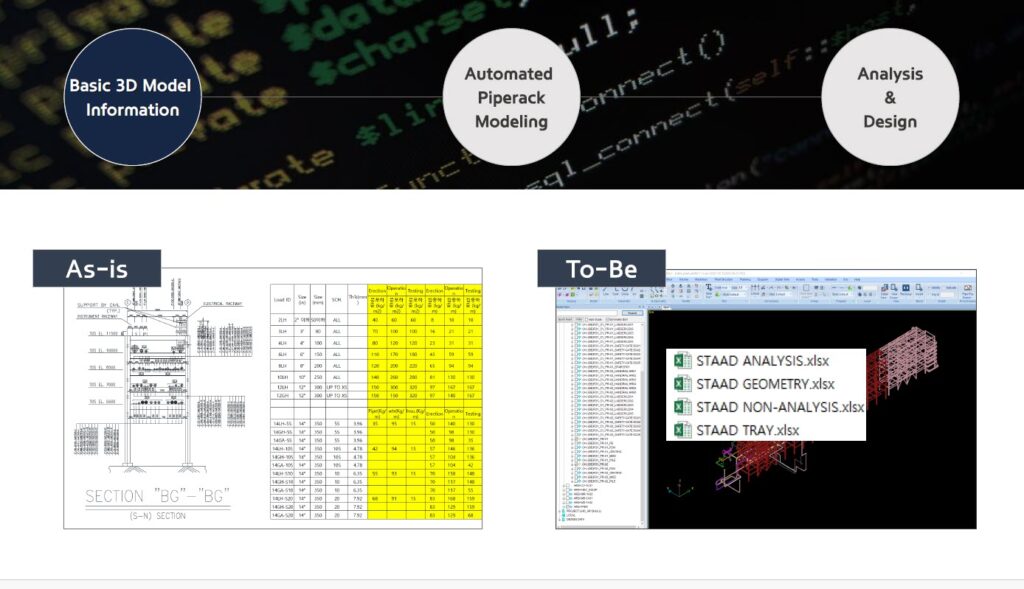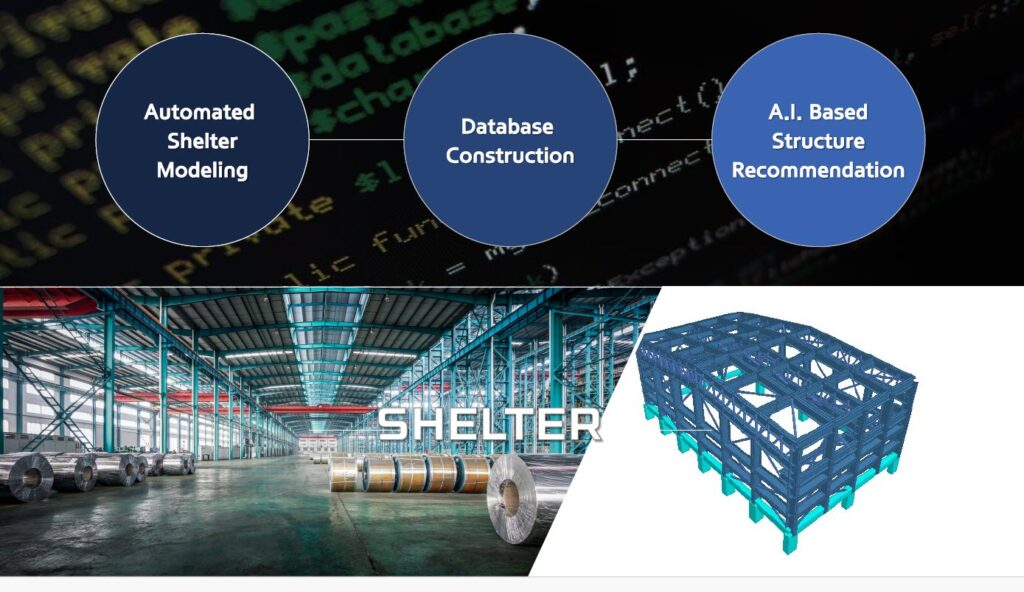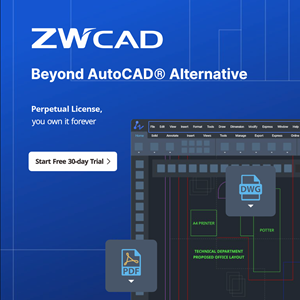Attending the Bentley Systems’ 2023 Year in Infrastructure and Going Digital Awards in Singapore was a fantastic experience. Engaging in a conversation with Dongwon Kim, General Manager of Hyundai Engineering & Construction Co., Ltd., South Korea, who later emerged as the winner in the Structural Engineering domain during the awards ceremony on the conference’s final day, was particularly insightful.
During our discussion, Dongwon Kim shared insights into their innovative project on the Automated Design of Civil and Architectural Structures using STAAD API. This project exemplifies how Hyundai Engineering has enhanced their workflows by embracing AI technology in structural engineering.
You can find the full interview here.
Tell us about Hyundai Engineering?
Leveraging our wealth of experience and cutting-edge technology, Hyundai Engineering is embarking on a journey towards a new era, aiming to emerge as a leader in construction and EPC. Our commitment involves contributing to the prosperity of humanity and the development of our nation by consistently embracing challenges.
Founded in 1974 as Hyundai Technology Development Co., Ltd., Hyundai Engineering has evolved into a prominent global engineering company that proudly represents Korea on the international stage. Throughout our extensive history, we have been dedicated to providing engineering solutions across various domains in Korea and around the globe, striving to enhance the quality of life with abundance and happiness.
At Hyundai Engineering, our focus revolves around creating customer value through diverse avenues, drawing on our extensive experience, superior technology, and talented workforce. With a steadfast commitment to excellence, positive thinking, a passion for innovation, and an unwavering dedication to continuous improvement, we are determined to thrive as a global engineering company, actively shaping a brighter future.

What led to the decision to incorporate this AI application into the project? How long has the utilization of AI technology been ongoing?
The incorporation of AI into our practices is relatively recent, having started approximately two years ago. Artificial Intelligence (AI) is making a profound impact on global industries, including structural engineering. Its capacity to analyze extensive datasets, recognize patterns, and make informed decisions is revolutionizing how structural engineers approach the design, analysis, and optimization of plant structures.
In structural engineering, AI is applied through advanced algorithms and machine learning techniques to streamline and enhance various aspects of the design and analysis process. This empowers our engineers with tools that swiftly and accurately analyze intricate structural systems, optimize designs, and assess the structural integrity of infrastructure.
Given the time-sensitive nature of all our projects, regardless of size, the challenge of meeting deadlines is a constant in Civil and Architectural design. The industry frequently grapples with time constraints, making it imperative to seek solutions that enhance efficiency. Automation, as a recommended approach, offers advantages in terms of time, cost, and resource optimization. Recently, AI has emerged as a pivotal component of automation, particularly in addressing challenges associated with large projects.
Our AI-based program serves as a valuable asset, enabling us to make more informed decisions, optimize project timelines and budgets, and ultimately enhance overall project outcomes.
Assuming you utilize BIM, could you elaborate on the unique advantages and distinct benefits of incorporating AI within these projects?
Hyundai Engineering is engaged in plant and building business projects and actively developing BIM to implement it up to 6D in the only building business projects.
In our plant projects, which are part of this automated program development, we use separate solutions based on 3D Modeling such as STAAD, S3D and Tekla. So we don’t utilized BIM in the plant projects for now unlike the building projects. The focus of this development in not on the BIM but rather on leveraging AI technology to automate engineering processes.
However, the development program involves integrating design information from a 3D CAD called S3D and automatically linking it with STAAD.
In the sense that design and analysis information are integrated, there may be some similarities with the concept of BIM.
Could you provide further details about the AI application developed for automating design processes? Is this application an add-on specifically developed for Bentley Systems’ STAAD or a related software?
The primary objective of our developed program is to rapidly create Bentley’s STAAD structural analysis models. Fortunately, STAAD provides an excellent APIs called OpenSTAAD, which allows us to automate difficult modeling tasks such as generating members and input loads. Once this automated modeling is completed, we can accumulate numerous design results into a database which can then be used for AI training. As a result, without the need for separate modeling efforts, we were able to create a program that can predict design outcomes or recommend optimized structural systems through AI.

How do Hyundai engineers navigate through the 1680 scenarios and 27 million prediction models to select the most appropriate model or specific scenario for their needs?
By inputting variables such as width, height, the number of columns and roof type. Engineers can automatically generate a complete structural model. Using this automated modeling, it is possible to quickly create 1680 models. By training machine learning on the correlation between these 1680 modeling results and the variables, it’s possible to generate 27 million prediction models.

In essence, this enables the automatic prediction of optimal structural systems and quantities without the need for manual modeling.
There are three sequential ways to utilize data. First creating descriptive models for data visualization to gain insights.
Second, using machine learning to learn the relationship between input and output values, enabling the creation of models that predict results for specific input values.
Lastly, in the third stage providing solutions by determining what input values need to be executed to obtain the optimal results. We have already developed a program through the third stage that recommends the optimal structural system, and we plan to further refine this approach to assist engineers in achieving the best designs.
What skill set is necessary for the development of AI applications? Was this solution created internally within your company, and what specific software or coding expertise is essential for its development?
As discussed before for modeling purposes, we utilize STAAD Pro due to its advanced flexibility. Internally, we’ve developed a program to automate modeling tasks. While Bentley Systems offers a plethora of APIs, not all aspects can be automated through APIs alone. Certain components require additional coding. Seeking advice from Bentley, we received guidance on optimizing tasks through APIs and coding.
To enhance AI accuracy, a substantial database is crucial. We employed automation to generate thousands of models, extracting essential design results such as quantities and structure types. This extensive database facilitated machine learning, enabling us to correlate input parameters with design outcomes. Consequently, predicting design results is now streamlined without the need for modeling, showcasing the fundamental impact of AI technology.
Looking ahead, I think AI holds the potential to empower engineers in optimizing structural configurations and materials. This involves considering environmental factors, adhering to international codes, and ensuring adherence to safety standards, ultimately leading to the creation of robust and resilient structures.
Is it possible to apply this AI solution to other projects?
Certainly, this solution is applicable to numerous upcoming projects. In plant projects, where commonalities often exist, rapid calculation of boiler costs, structural sizing, and prompt client information submission is crucial. Our AI program addresses these challenges effectively, offering fast design result calculations through appropriate input, irrespective of the project type. This enables swift project bidding and success.
The versatility of our AI program is evident as, regardless of project variations, the underlying principles of structures and design remain consistent. Consequently, we can confidently assert that this AI program can be seamlessly applied to diverse projects.
The role of AI in design will likely expand, contributing to the creation of structures that not only prioritize efficiency but also embrace sustainability. This involves the incorporation of innovative materials and construction techniques in the structural design process.
What guidance would you offer to structural engineers regarding the utilization of AI?
Efficiency lies in the heart of civil and architectural projects, and automation plays a pivotal role. The process begins with automation, leading to extensive data accumulation and subsequent AI predictions. To fellow professionals in the structural engineering field, my advice is that to harness the power of AI, one must first equip themselves with a substantial dataset through automation.
The adoption of AI empowers structural engineers to advance their expertise, improve project outcomes, and actively participate in establishing safer and more sustainable built environments. The future of structural engineering holds great promise, as AI guides the field toward an era defined by intelligent, adaptive, and resilient structures. I believe engineers globally should prepare to integrate AI into their projects, seek assistance from Bentley, and anticipate the proliferation of AI applications in the years to come.

I extend my gratitude to Dongwon Kim, for the insightful discussion. If you have any questions for him or for DailyCADCAM, please feel free to leave a comment below or contact us via email at sachin@dailycadcam.com. We are more than happy to provide answers and further information.
Thank you,
Sachin Nalawade, Editor DailyCADCAM





